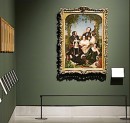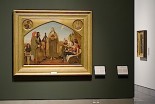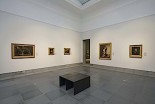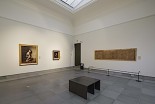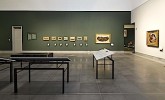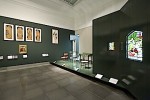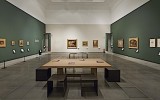The browser will either open the file, download it, or display a dialog.
Ford Madox Brown: Pre-Raphaelite Pioneer
Manchester City Art Gallery
September 24 – January 29, 2012
Museum of Fine Arts, Ghent
February 25 – June 3, 2012
Catalogue:
Julian Treuherz, with introductions by Robert Hoozee and Maria Balshaw,
Ford Madox Brown.
Brussels: Museum of Fine Arts, Ghent in association with Mercatorfonds, 2012.
160 pp., 115 color illustrations; chronology of the artist’s life; selected bibliography.
€ 24
ISBN: 978 90 6153 627 7
Ford Madox Brown: Pre-Raphaelite Pioneer offers a retrospective view of the oeuvre of this nineteenth-century British artist. Though Ford Madox Brown (1821–93) never actually joined the Pre-Raphaelite Brotherhood, he was one of the main representatives of this British art movement. As the master of Dante Gabriël Rossetti (1828–82) and friend to many of the Pre-Raphaelite followers, he was closely affiliated with the group and both introduced and adopted some of the main principles of the Pre-Raphaelite Brotherhood. This exhibition aims to prove that Brown can even be considered as a Pre-Raphaelite pioneer, since he already developed a Pre-Raphaelite style before the Brotherhood was founded. Nevertheless, despite Brown’s importance, this is only the third monographic exhibition devoted to his oeuvre. Though the display of his work started off very promisingly with an early, contemporary monographic exhibition organized by the painter himself in 1865, it was not until Mary Bennet’s exhibition, Ford Madox Brown 1821–1893, at the Walker Art Gallery in Liverpool almost one hundred years later, that Brown’s major oeuvre was gathered and appreciated within modern scholarship.
The Manchester Art Gallery and its guest curator Julian Treuherz decided it was time to re-assess Ford Madox Brown’s oeuvre in a retrospective exhibition, gathering together all the artist’s major works. Afterwards, the exhibition travelled to the Museum of Fine Arts in Ghent, which was an excellent choice, considering the museum’s affinity with British art. Ford Madox Brown: Pre-Raphaelite Pioneer, as well as the recent exhibition of John Constable’s (1776–1837) oil sketches from the Victoria and Albert Museum, extends the trend set in 2007 by the exhibition British Vision curated by Dr. Robert Hoozee at the museum in Ghent. British Vision encompassed an impressive display of some two hundred years of British art and also featured Brown’s painting The Last of England (1852–55).[1] The fact that Ford Madox Brown’s oeuvre is singled out for this exhibition also reflects the artist’s association with Belgium during his years of study in Bruges, Ghent, and Antwerp.[2] The exhibition in Ghent, therefore, is completed with works by his Belgian contemporaries, such as Gustaaf Wappers (1803–74), whose Romantic historical pieces influenced Brown.
Though the museum’s curator Robert Hoozee unfortunately passed away during the preparations for this exhibition, Ford Madox Brown: Pre-Raphaelite Pioneer still echoes his vision and great knowledge about British art during the nineteenth century. The Museum of Fine Art’s classic halls prove to be an excellent setting for Brown’s elegant pieces. In most cases, the artworks are presented with the original gilt frame that the artist designed, providing them with a majestic and unique character. The spectator is guided past the highlights of Ford Madox Brown’s oeuvre and comes to realize that this painter was definitely one of the more eccentric English artists of his time.
As usual, the east wing of the museum is reserved for temporary exhibitions, which in this case comprises six rooms. Throughout the entire exhibition, thematic groups of artworks are formed. First, a room is devoted to Brown’s early work and his theatrical drawings from the King Lear-cycle (1843–44). The second room includes his commissioned pieces, as well as his works about English literature, and envision an artistic turning point in his career, while the third hall introduces some of Brown’s Belgian contemporaries. The next room offers the spectator his most famous paintings of modern life and his landscapes. Finally, two rooms demonstrate Brown’s designs for stained glass windows and furniture, and his portraits, combined with some of his final works.
Though some sense of chronology is maintained within these thematic groups, it is somewhat difficult to understand the relation between the themes and the chronology of Brown’s work. However, it must be noted that arranging the artist’s works in a chronological order proves to be a difficult task. Due to his accurate painting technique and his tendency to represent every detail, it often took Brown years to finish a painting, and even after their completion, the painter could hardly restrain himself from adding changes to his works. The museum, therefore, has succeeded reasonably well in finding a ‘natural order’ for presenting his works, by composing a thematic structure. Moreover, some strategically positioned, larger wall texts explain the thematic groups to the audience and at the same time provide information about Brown’s life and work, supplying the right amount of information that one is inclined to read.[3]
From start to finish, a deep green color is used throughout the exhibition rooms, occasionally combined with a fresh white. Evaluating the choice for this palette, a fragment from the diary Brown so meticulously wrote comes to mind. While walking through the countryside witnessing nature’s beauty, Brown mentions “the greeny greyness of the unmade hay in furrows or tufts.”[4] Whether deliberate or not, this color seems mimicked by the halls of the museum and suits the presentation of Brown’s work well. Furthermore, the lighting in general is kept rather dark, while the artworks are highlighted with spotlights. As is usually the case in the museum in Ghent, the highlighting of the individual pieces is done exquisitely, so no disagreeable reflections of light on the paintings are visible. For this exhibition, the museum’s skylights, allowing the use of daylight, have been covered, creating a more intimate atmosphere and enhancing Brown’s rich color palette.
Room 1: Brown’s Theatricality
The first exhibition room is devoted to Brown’s early work and introduces the artist to the spectator (fig. 1). The biographical formalities are settled by a short, yet adequate introduction printed on the wall, combined with a painting by Brown of the Bromley family, picturing his first wife and her family (fig. 2). This first room also comprises some of Brown’s fascinating portraits, such as Boy’s Head (1836), or the beautiful sketch, possibly of Brown’s friend and fellow student in Antwerp, Daniel Casey (1848). Portraits turn out to be a connecting thread through Brown’s oeuvre, which is envisaged throughout the entire exhibition. In contrast to the line of smaller portraits in this first room, the centerpiece of this hall is Brown’s large painting Manfred on the Jungfrau (1861). The spectator’s attention is immediately drawn to this colorful, theatrical work, as Lord Byron’s character Manfred, haunted with guilt and a desire for death, is at the brink of jumping from a snowy cliff. This theatricality becomes even more evident when the few works painted by Brown while he studied in Paris are considered. The influence of French romantic painters, such as Eugène Delacroix (1798–1863) and Paul Delaroche (1797–1856), is clearly noticeable, though Brown’s works seem less polished and conceal hints of satire.[5]
Brown’s eye for detail and his ability to stage a theatrical scene can perhaps be most appreciated in his works of art depicting scenes that he, supposedly, sketched directly from observing the theatre stage. In this first exhibition room, the beautiful drawings depicting the King Lear cycle (1843–44) embody all of Shakespeare’s dramatic qualities, yet also show how Brown distanced himself from the modeled drawing technique and idealized proportions he had adopted during his stay in Belgium.[6] Though the Pre-Raphaelite critic William Michael Rossetti (1829–1919) praised Brown’s drawings, these spontaneous and expressive sketches were generally considered primitive and unfinished by his contemporaries.
Room 2: A Turning Point
In the second exhibition room, a corner is devoted to Brown’s competition pieces (fig. 3). These large studies, designed for the newly built Houses of Parliament in London, enabled Brown to demonstrate his experience with majestic, figurative painting that he adopted while studying in Antwerp. The Body of Harold brought before William the Conqueror (1844–61) and Study for ‘Spirit of Justice’ (1844–45) are two of the examples exhibited. These works are joined by paintings from a turning point in Brown’s life and career. After traveling to Italy, Brown’s wife Elisabeth’s feeble health finally gave out during the return journey to England. As is clearly envisioned in the exhibition, her death greatly influenced Brown’s art, as he turned to a brighter palette and a more naturalistic style to introduce ‘air and sunlight’ into his historical pieces. The Italianate Madonnas he painted during this period, also reminiscent of the Early Netherlandish masterpieces Brown saw in Belgium, are represented in the exhibition by The Seraph’s Watch (1847) and Oure Ladye of Saterday (1847–61).[7] These two intense and colorful pieces contrast with the sober, yellow-brown tones of the previously mentioned studies in the same room and demonstrate the foreign influence in his oeuvre.
Also in this second hall, a wall is devoted to Brown’s paintings about the origins of English literature. The First Translation of the Bible into English: Wycliffe Reading his Translation of the New Testament to his Protector, John of Gaunt, Duke of Lancaster, in the Presence of Chaucer and Gower, his Retainers (1847–86) is a symmetrical and pale painting of the barefooted, religious reformer, joined by poet Geoffrey Chaucer and John Gower, and accompanied by his protector, John of Gaunt (fig. 4). This piece demonstrates Brown’s fascination with English literature and the work of Chaucer in particular. Yet, despite his great respect for this subject, Brown also adds a touch of humor to this scene, as he has depicted the infant daughter of John of Gaunt among the listening audience, sound asleep on her mother’s lap. Moreover, Brown’s affiliation with Chaucer is also visible in other works in this corner of the exhibition, such as The Seeds and Fruits of English Poetry (1845–53) or Geoffrey Chaucer Reading the ‘Legend of Custance’ to Edward III and his Court (1850–64).
Room 3: Brown’s Belgian Contemporaries
Next, the spectator enters the third hall exhibiting some of Brown’s Belgian contemporaries (fig. 5). The contrast with the other exhibition rooms is striking, as this is the only hall with white walls and natural daylight. This turns out to be a strategic choice, since the palette of the Belgian romantic painters is much darker compared to Brown’s. Three paintings by Brown’s Antwerp master, the romantic painter Gustaaf Wappers, are present in this room, combined with a Self-Portrait (1817) by his master from Ghent, Pieter Van Hanselaere (1786–1862). There is also a painting Walk outside the Walls (Meeting of Faust and Gretchen) (1854) by Henri Leys (1815–69), whom Brown never actually met, yet recognized as a fellow artist with similar ambitions. The large drawing on paper presenting The Departure of Baldwin IX to the Holy Land by Brown’s fellow student in Antwerp Godfridus Luppen (1823–1901), perhaps shows the highest resemblance with Brown’s compositions and eye for detail (fig. 6).
Though some very convincing works are displayed in this gallery, and the link with Brown’s oeuvre is visibly comprehensible, there is no explanatory wall text provided here. Only a few visitors notice the information booth at the entrance of the room, from which an explanatory paper sheet can be extracted. This sheet provides details about Brown’s whereabouts in Belgium and partially explains the presence of the Belgian works in this room. However, it is unfortunate that this information does not appear as a wall text, which would have made matters much clearer. Also, there are no smaller, explanatory texts accompanying the Belgian works, so it is quite difficult to estimate the impact of these works on Brown. Some of the paintings by Wappers and the drawing of Van Luppen are undated, so again it is not really clear if, and in what way, these works influenced Brown.
As it turns out, these six works are the only Belgian paintings included in the exhibition, which is a pity. Clearly, the potential of confronting Brown’s work with Belgian art, and perhaps even other contemporary European works is not fully exploited. However, this allows the focus of this exhibition to remain strongly on Brown’s oeuvre. As every choice combines loss with gain, this decision points out the further potential of exhibiting Brown’s work in a broader European context, an ambition which will hopefully be realized by future exhibitions.
Room 4: The Artistic Highlights
While entering the next exhibition room, one gets the impression that everything in the exhibition has been leading up to this largest, central room, where Brown’s most famous works are displayed (fig. 7). The intimate Waiting: An English Fireside of 1854–1855 (1851–55), the somewhat disturbing Take your Son, Sir (1851–60), the gloomy Stages of Cruelty (1856–90) and the beautiful, sunny The Pretty Baa-lambs (1851–59), are aligned on one side of the room, emphasizing Brown’s abilities to transfer emotions and the moralist tone of these works. Moreover, this section of the exhibition introduces a stage of his career, in which the brightness of his palette seems to have reached unknown heights. Also, the landscapes in this room display a perhaps lesser known part of his oeuvre (fig. 8). The exquisite A Study on the Brent at Hendon (1854–55), An English Afternoon, Hampstead (1852–61) or Carrying Corn (1854) might surprise those less familiar with this aspect of Brown’s work, as these landscapes demonstrate Brown’s meticulous painting technique, yet also illustrate his obstinate character. Even nineteenth-century critics considered Brown’s landscapes as a bit unusual. For instance, when John Ruskin (1819–1900) noticed the oval painting An English Afternoon, during a visit to Brown’s studio in 1855, he praised the fine painting technique, yet also asked Brown what made him “take such a very ugly subject” of two young lovers looking out toward Highgate, London. Brown merely answered that the scenery “laid out of the back of his window.” [8] Eventually, it took Brown several years to finish the painting, which resulted in a simultaneous representation of multiple seasons in a single painting, contributing to the surprising uniqueness of this landscape.
Combined with these landscapes, are some of Brown’s most famous masterpieces. The Last of England (1852–55) and Work (1865) demonstrate his fascination with modern life, while the sketches on the adjoining wall confirm his amazing eye for detail. Experimenting with poses, anatomy, and expression, Brown’s pencil drawings capture a glimpse of his artistic genius, which is convincingly envisaged in this large exhibition hall.
In the center of this room, several tilted tables are aligned, providing detailed information about Brown’s largest, and probably most ambitious, painting Work. A structured analysis of the painting’s iconography is made by pointing out the different characters on the canvas. For instance, ‘the poor children’ in the foreground of the painting look dirty and are dressed in rags, while the baby is wearing black ribbons signaling that her mother has recently passed away. The ‘three dogs’ surrounding these children represent the different social classes, as the greyhound symbolizes the higher class, the bull terrier represents the strength of the working class, and the mongrel is a companion to the poor orphans. It is a good thing that these and other details are pointed out and explained to the audience, because Brown himself considered this painting as a sort of life pursuit and continuously kept adding changes and details to it. Moreover, the busy composition lacks a clear center, while the numerous painted details make it difficult for the spectator to grasp this painting. However, thanks to the texts the museum has provided, the audience is visually guided through this complex masterpiece.
Room 5 and 6: Designs and Later Work
At first glance, the last two rooms of the exhibition tone down the artistic highlights displayed in the center room. Instead of ending with a bang, the thematic line throughout the exhibition is maintained, and another aspect of Brown’s oeuvre, namely his furniture designs and stained glass windows, are presented to the spectator (fig. 9). Brown himself considered his Egyptian chair (1858), or the ‘Sussex’ chair with a round base (1865), as equally important as his paintings, making him one of the Arts and Crafts Movement’s pioneers. Also, the exhibition features two stained glass windows and several of his cardboard designs for stained glass windows, for instance depicting The Marriage of St. Editha (1873–78).[9] Brown’s design is successfully displayed at the height of the original windows, so the spectator experiences the effects and proportions of the work as Brown himself intended them.
Finally, the last exhibition room introduces Brown’s later work, focusing on his abilities as a storyteller and some of his portraits (fig. 10). Brown often depicted biblical scenes such as Elia and the Widow’s Son (1869), picturing the supposedly dead son of a sick widow, who is revived by the prophet Elia and returned to his grateful mother. A symbolic connotation is added to his diagonal composition by means of a shadow of nesting swallows, representing the return of the son’s soul to his body.
Works such as Cordelia’s Portion (1869) or Byron’s Dream illustrate not only Brown’s fascination with literature, but also the influence of Dante Gabriël Rossetti and his Pre-Raphaelite colleagues. Moreover, another series of portraits is displayed in this room, showing The English Boy (1860), a defiant little girl in Mauvais Sujet, The Writing Lesson (1862), and Brown’s wife and most beloved model, Emma, in Thinking (1869). The small, yet beautiful portrait of Brown’s daughter Lucy (1859), dressed in a simple garment topped with a droopy rose hanging from her collar, is characterized by a unique simplicity. Brown’s delicate technique and abilities as a portrait painter are confirmed, while the confronting gaze of the little girl does not miss its disarming effect on the spectator.
The Irish Girl (1860), chosen as the campaign image for the exhibition and cover of the catalogue, is one of the final pictures in the exhibition. So, it becomes clear that the choice for this image of a girl holding a cornflower was indeed just. The painting seems exemplary for Brown’s detailed technique and rich palette, yet also gives away his eccentric character, since Brown has presented the girl as an individual with a pronounced personality, allowing the child’s character to shine from the portrait. The image of this girl is already very familiar to the spectator, as it is widespread as an advertisement for the exhibition. Yet, the luminescent colors and excellent setting the museum has created merely confirm the suspicion that only witnessing the real painting allows the spectator to truly experience and appreciate Brown’s work.
The subtle portraits in the final room complete the circle, which defines the exhibition, and linger in the spectator’s mind when leaving the green halls of the museum. About everything Brown did, there was a hint of originality. Just as Brown created an original kind of history painting for himself, this exhibition provides a new thematic structure to grasp his diverse and complex oeuvre. Whether completely sufficient or not, the order in which his paintings are presented, and the presence of his lesser known landscapes, make it easier to imagine the “lovely violet shadows & long shades of the trees” Brown described in his diary.[10] Also, this exhibition has succeeded in guiding the spectator through some of Brown’s most intriguing and difficult works, convincing the audience that he can rightfully be considered a Pre-Raphaelite pioneer.
Jana Wijnsouw
PhD Candidate, Special Research Fund (BOF),
Ghent University - Department of Art History,
Jana.Wijnsouw[at]Ugent.be
The author would like to thank the editors of Nineteenth-Century Art Worldwide, Dr. Johan De Smet, Michel Burez, and Marhielde Wiels of the Museum of Fine Arts in Ghent for supplying the photographs in this review and for permitting their reproduction. Also, a special thank you to my supervisor Prof. Dr. Marjan Sterckx for her valuable corrections and suggestions.
[1]British Vision (October 6, 2007 – January 23, 2008, Museum of Fine Arts in Ghent) featured over 300 paintings, sculptures, sketches, prints, and photographs, mostly on loan from the Tate Gallery, the Victoria and Albert Museum, the Yale Centre for British Art, but also from smaller holdings and private collections. Another recent exhibition in the Museum of Fine Arts in Ghent dedicated to British art focused on the painter John Constable (1776–1837), showing several of his renowned masterpieces from the collection of the Victoria and Albert Museum in London.
[2] Brown first studied one term at the Academy of Bruges under Albert Gregorius (1774–1853), and then left for Ghent in 1836. There, Pieter Van Hanselaere (1786–1862) was his master for two years, while Brown also exhibited at the local salon. In 1838, the reputation of Gustaaf Wappers convinced Brown to move to Antwerp, where he studied with Jozef Van Lerius (1823–76), Karel Verlat (1824–90) and Godefridus Guffens (1823–1901) at the Academy. Though these painters, especially Luppens, influenced his work, the presence of the Early Netherlandish paintings and 17th-century Antwerp paintings probably left a more profound impression.
[3] These texts are also incorporated in the exhibition catalogue. Concerning this catalogue, the chosen artwork and letter design are to be complemented, as the informed spectator will recognize an Arts and Crafts-like design as a subtle reference to Brown’s affiliations with this group.
[4] Ford Madox Brown, as quoted in Virginia Surtees, ed., The Diary of Ford Madox Brown (New Haven and London: Yale University Press, 1981), 145.
[5] The influence of the oeuvre of William Hogarth (1697–1764), whom Brown greatly admired, is obvious.
[6] In total, the King Lear Cycle contains sixteen illustrations, based on William Shakespeare’s play. Ford Madox Brown: Pre-Raphaelite Pioneer in Ghent features a selection of six of these drawings, all originating from the collection of the Withworth Art Gallery, University of Manchester.
[7] Brown adopted aspects of the Italian Renaissance, Flemish paintings, and the style of the Nazarenes he met in Rome. By combining these foreign influences, he created his own personal style, while depicting typical English subjects. This unique combination of uncompromising realism and modern subjects made him a Pre-Raphaelite avant la lettre and clearly influenced Rossetti and his friends.
[8] Brown, as quoted in Surtees, ed., The Diary of Ford Madox Brown, 144.
[9] The present stained glass windows are titled Pruning (The Woodcutter) and The Death of Sir Tristan (1862) and are illuminated by a light positioned behind the glass. The other designs for windows are accompanied by photographs of the real windows, demonstrating their effect in real life.
[10] Brown, as quoted in Surtees, ed., The Diary of Ford Madox Brown, 145.



